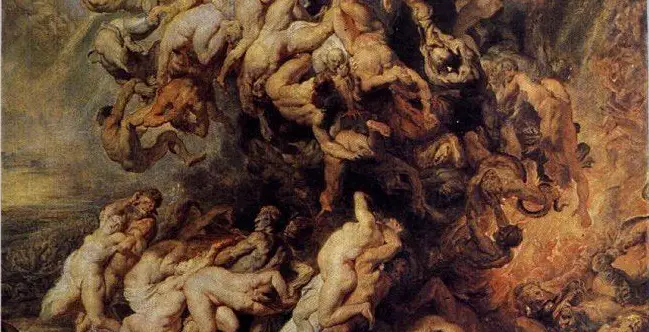“Dies Irae” is a Latin hymn from the 13th century, often associated with the Day of Judgment in Catholic tradition.
It has been used in a variety of musical settings, including orchestral, choral, and solo piano arrangements.
Contents
- Mozart’s Requiem Mass in D minor
- Karl Klindworth’s Piano Arrangement
- Sheet Music for the Karl Klindworth Piano Arrangement
- What is the subject/theme of the original hymn?
- Mozart’s Original Orchestral Composition
- What does “Dies Irae” Translate To?
- Lyrics of the Original Latin Hymn and Translation
- Famous Versions of “Dies Irae”
- Brief Biography of Klindworth
Mozart’s Requiem Mass in D minor
Wolfgang Amadeus Mozart composed his own setting of “Dies Irae” as part of his Requiem Mass in D minor, K. 626, which was left unfinished at the time of his death in 1791.
Mozart’s “Dies Irae” is a powerful and dramatic musical depiction of the day of judgment, featuring intense choral writing and a strong sense of urgency and tension.

This section of the Requiem is one of the most well-known and frequently performed pieces of classical music, and continues to be a staple of choral concerts and liturgical services today.
Karl Klindworth’s Piano Arrangement
Here’s a video of Klindworth’s arrangement for piano, including the sheet music and piano keys.
Karl Klindworth was a German pianist, conductor, and composer active in the late 19th and early 20th centuries.
He was a prominent figure in the world of classical music, and was known for his virtuosity as a pianist, as well as his work as a conductor and music editor.

Klindworth was also a close associate of composer Franz Liszt, and played a significant role in promoting Liszt’s music throughout his career.
He was particularly influential in Germany and Russia, where he performed and conducted concerts and helped to establish the repertoire of the piano and orchestral music of his time.
Sheet Music for the Karl Klindworth Piano Arrangement
What is the subject/theme of the original hymn?
“Dies Irae” is a Latin hymn that dates back to the 13th century.
It is typically associated with the theme of judgment and the end of the world, and is often used in Catholic liturgical services as part of the requiem mass, a Mass for the dead.
The text of “Dies Irae” describes the Day of Judgment, when all souls will be called before God to be judged for their deeds in life.

It reflects on the terror of that day, the reckoning of all souls, and the eventual separation of the righteous from the wicked.
The hymn expresses fear and awe at the power of God and the certainty of judgment, but also a hope for mercy and forgiveness.
In musical settings, “Dies Irae” is often depicted as a dramatic and intense piece, with powerful choral writing and a sense of urgency and tension.
Mozart’s Original Orchestral Composition
Here’s a video of a performance of the original Mozart setting.
What does “Dies Irae” Translate To?
“Dies Irae” is a Latin phrase that translates to “Day of Wrath” or “Day of Judgment.”
It refers to the day when, according to Christian belief, all souls will be judged by God and sent to either heaven or hell.
The phrase has become associated with the theme of judgment, particularly in Western classical music where it is often used in compositions depicting the end of the world or the final judgment.
Lyrics of the Original Latin Hymn and Translation
| Original | Approved Adaptation | Formal Equivalence | |
| I | Dies iræ, dies illa, Solvet sæclum in favilla: Teste David cum Sibylla. | Day of wrath and doom impending! David’s word with Sibyl’s blending, Heaven and earth in ashes ending! | The day of wrath, that day, will dissolve the world in ashes: (this is) the testimony of David along with the Sibyl. |
| II | Quantus tremor est futurus, Quando Iudex est venturus, Cuncta stricte discussurus! | Oh, what fear man’s bosom rendeth, When from heaven the Judge descendeth, On whose sentence all dependeth. | How great will be the quaking, when the Judge is about to come, strictly investigating all things! |
| III | Tuba, mirum spargens sonum Per sepulchra regionum, Coget omnes ante thronum. | Wondrous sound the trumpet flingeth; Through earth’s sepulchres it ringeth; All before the throne it bringeth. | The trumpet, scattering a wondrous sound through the sepulchres of the regions, will summon all before the throne. |
| IV | Mors stupebit, et natura, Cum resurget creatura, Iudicanti responsura. | Death is struck, and nature quaking, All creation is awaking, To its Judge an answer making. | Death and nature will marvel, when the creature will rise again, to respond to the Judge. |
| V | Liber scriptus proferetur, In quo totum continetur, Unde mundus iudicetur. | Lo, the book, exactly worded, Wherein all hath been recorded, Thence shall judgement be awarded. | The written book will be brought forth, in which all is contained, from which the world shall be judged. |
| VI | Iudex ergo cum sedebit, Quidquid latet, apparebit: Nil inultum remanebit. | When the Judge his seat attaineth, And each hidden deed arraigneth, Nothing unavenged remaineth. | When therefore the Judge will sit, whatever lies hidden, will appear: nothing will remain unpunished. |
| VII | Quid sum miser tunc dicturus? Quem patronum rogaturus, Cum vix iustus sit securus? | What shall I, frail man, be pleading? Who for me be interceding, When the just are mercy needing? | What then shall I, poor wretch [that I am], say? Which patron shall I entreat, when [even] the just may [only] hardly be sure? |
| VIII | Rex tremendæ maiestatis, Qui salvandos salvas gratis, Salva me, fons pietatis. | King of Majesty tremendous, Who dost free salvation send us, Fount of pity, then befriend us! | King of fearsome majesty, Who gladly save those fit to be saved, save me, O fount of mercy. |
| IX | Recordare, Iesu pie, Quod sum causa tuæ viæ: Ne me perdas illa die. | Think, kind Jesu! — my salvation Caused Thy wondrous Incarnation; Leave me not to reprobation. | Remember, merciful Jesus, that I am the cause of Your journey: lest You lose me in that day. |
| X | Quærens me, sedisti lassus: Redemisti Crucem passus: Tantus labor non sit cassus. | Faint and weary, Thou hast sought me, On the Cross of suffering bought me. Shall such grace be vainly brought me? | Seeking me, You rested, tired: You redeemed [me], having suffered the Cross: let not such hardship be in vain. |
| XI | Iuste Iudex ultionis, Donum fac remissionis Ante diem rationis. | Righteous Judge, for sin’s pollution Grant Thy gift of absolution, Ere the day of retribution. | Just Judge of vengeance, make a gift of remission before the day of reckoning. |
| XII | Ingemisco, tamquam reus: Culpa rubet vultus meus: Supplicanti parce, Deus. | Guilty, now I pour my moaning, All my shame with anguish owning; Spare, O God, Thy suppliant groaning! | I sigh, like the guilty one: my face reddens in guilt: Spare the imploring one, O God. |
| XIII | Qui Mariam absolvisti, Et latronem exaudisti, Mihi quoque spem dedisti. | Through the sinful woman shriven, Through the dying thief forgiven, Thou to me a hope hast given. | You Who absolved Mary, and heard the robber, gave hope to me also. |
| XIV | Preces meæ non sunt dignæ: Sed tu bonus fac benigne, Ne perenni cremer igne. | Worthless are my prayers and sighing, Yet, good Lord, in grace complying, Rescue me from fires undying. | My prayers are not worthy: but You, [Who are] good, graciously grant that I be not burned up by the everlasting fire. |
| XV | Inter oves locum præsta, Et ab hædis me sequestra, Statuens in parte dextra. | With Thy sheep a place provide me, From the goats afar divide me, To Thy right hand do Thou guide me. | Grant me a place among the sheep, and take me out from among the goats, setting me on the right side. |
| XVI | Confutatis maledictis, Flammis acribus addictis, Voca me cum benedictis. | When the wicked are confounded, Doomed to flames of woe unbounded, Call me with Thy saints surrounded. | Once the cursed have been silenced, sentenced to acrid flames, Call me, with the blessed. |
| XVII | Oro supplex et acclinis, Cor contritum quasi cinis: Gere curam mei finis. | Low I kneel, with heart’s submission, See, like ashes, my contrition, Help me in my last condition. | [Humbly] kneeling and bowed I pray, [my] heart crushed as ashes: take care of my end. |
| XVIII | Lacrimosa dies illa, Qua resurget ex favílla Iudicandus homo reus: Huic ergo parce, Deus: | Ah! that day of tears and mourning, From the dust of earth returning Man for judgement must prepare him, Spare, O God, in mercy spare him. | Tearful [will be] that day, on which from the glowing embers will arise the guilty man who is to be judged: Then spare him, O God. |
| XIX | Pie Iesu Domine, Dona eis requiem. Amen. | Lord, all-pitying, Jesus blest, Grant them Thine eternal rest. Amen. | Merciful Lord Jesus, grant them rest. Amen. |
Famous Versions of “Dies Irae”
The original hymn has been arranged and performed by many composers over the centuries. Some of the most famous arrangements include:
- Wolfgang Amadeus Mozart’s Requiem Mass in D minor, K. 626: This work is one of the most famous musical settings of “Dies Irae” and is considered one of Mozart’s greatest works.
- Giuseppe Verdi’s Requiem Mass: Verdi’s requiem is another popular setting of “Dies Irae” and is known for its dramatic intensity and powerful choral writing.
- Hector Berlioz’s Grande Messe des morts (Requiem Mass): Berlioz’s requiem features a powerful setting of “Dies Irae” that is characterized by its use of large orchestras and choruses.
- Franz Liszt’s Totentanz (Dance of Death): This work is a solo piano piece that features “Dies Irae” as its main theme. It is known for its virtuosity and its imaginative use of the piano to convey a sense of terror and awe.
These are just a few of the many famous arrangements of “Dies Irae.” The hymn remains a popular subject for composers to this day, and new arrangements continue to be created and performed.
Brief Biography of Klindworth
Karl Klindworth (1830-1916) was a German pianist, conductor, and composer known for his interpretations of the works of Richard Wagner.
Klindworth was born in Hanover, Germany on September 25, 1830.
He began studying piano at a young age and went on to study at the Leipzig Conservatory under Ignaz Moscheles and Felix Mendelssohn.
In 1852, Klindworth became a student of Franz Liszt in Weimar, and the two developed a close friendship that lasted for many years.
Klindworth became a renowned interpreter of Liszt’s works and also arranged some of Liszt’s orchestral works for solo piano.
In 1856, Klindworth became a conductor at the Königstädtisches Theater in Berlin. He later held conducting positions at the Munich Court Opera and the Hamburg State Opera.
Klindworth is perhaps best known for his work with Richard Wagner. He served as Wagner’s répétiteur during the composer’s exile in Switzerland in the 1860s and helped him prepare the score for the premiere of Tristan und Isolde in 1865.
Klindworth also conducted the premiere of Die Meistersinger von Nürnberg in Munich in 1868.
Klindworth composed a number of works, including piano pieces, songs, and chamber music. He also wrote a book about his experiences with Liszt, titled “Meine Erinnerungen an Franz Liszt.”
Karl Klindworth died in Berlin on July 27, 1916. He is remembered as a talented musician and important figure in the history of German classical music.
Dies Irae, the hymn of judgment day,
Played out on the piano in a moving way.
Notes that seem to come from heaven above,
Describing the terror and power of the Lord’s love.
Each chord resounds like a thunderous peal,
As if to say that the end is near, that all will feel
The weight of judgment, the reckoning of the past,
And know that they will stand before the Lord at last.
Yet within the music, there is a glimmer of hope,
A prayer for mercy, a desire to cope
With the fears of judgment, the doubts of the heart,
And find a path to peace and a brand new start.
So let the music fill the heart and soul,
As it tells the story of judgment day, whole,
And may it bring comfort, a sense of release,
And a path to salvation, a life of peace.
